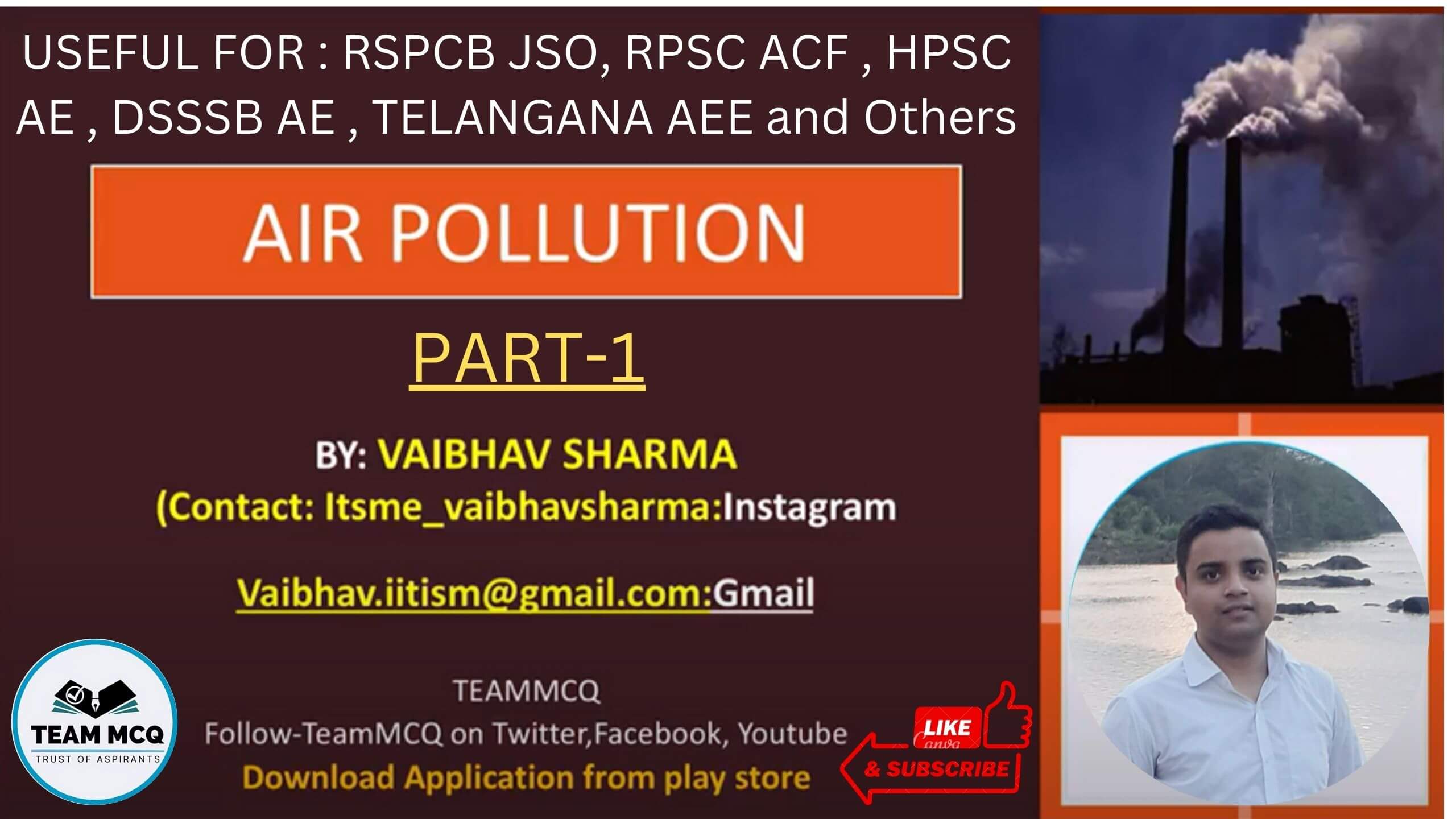Air pollution is one of the most pressing environmental challenges facing the world today. As populations grow, industrial activities intensify, and transportation networks expand, the quality of air deteriorates, posing significant threats to human health, ecosystems, and the climate. Environmental engineering plays a crucial role in understanding, managing, and controlling air pollution to ensure cleaner air for future generations. For more information visit website https://cpcb.nic.in/national-air-quality-index/
AIR POLLUTION: ENVIRONMENTAL ENGINEERING
Presence of one or more air pollutants/ contamitants in such concentration and for such duration that life on biosphere gets affected. Earth’s atmosphere is composed of about 78% nitrogen, 21% oxygen, and 0.93% argon. The remainder, less than 0.1%, contains such trace gases as water vapor, carbon dioxide, and ozone.
Major Classification of Air Pollutants:
1] Primary – Secondary
2] Natural – Manmade
3] Criteria Air Pollutants
4] Physical – chemical – biological
Primary air pollutants in Environmental engineering
Primary pollutants: Primary pollutants are substances that are directly emitted into the atmosphere from sources. Primary pollutants are those that are emitted directly from identifiable sources.
(i)Fine (less than 100μ) and coarse (more than 100μ) suspended particulate matter
(ii)Oxides of sulfur
(iii)Oxides of nitrogen
(iv)Carbon monoxide
(v)Halogens
(vi)Organic compounds
(vii)Radioactive compounds
Secondary air pollutants in Environmental engineering
Secondary air pollutants : produced in the air by the interaction of two or more primary air pollutant in the presence of sunlight.
(i) Ozone
(ii) PAN (peroxi aceyl nitrate)
(iii) Photochemical smog
(iv) Acid mists
(v) H2SO4
(vi) Formaldyhide
Aerosols in Environmental Engineering
Aerosols: Aerosols refer to the dispersion of solid or liquid particles of microscopic size in the air. It can also be defined as a colloidal system in which the dispersion medium is gas and the dispersed phase is solid or liquid. The term aerosol is applicable until it is in suspension and after settlement due to its own weight or by addition with other particles (agglomeration) it is no longer an air pollutant. The diameter of the aerosol may range from 0.01 (or less) micron to 100 micron. The various aerosols are as follows:-
(i) Dust: Dust is produced by the crushing, grinding and natural sources like windstorms. Generally the dust particles are over 20 micron in diameter. They do not flocculate but settle under gravity, but smaller particles like 5 micron form stable suspensions.
(ii) Smoke: Smoke is made up of finely divided particles produced by incomplete combustion. Generally it consists of carbon particles of size less than 1.0 micron.
(iii) Mists: Mist is a light dispersion of minute water droplets suspended in the atmosphere ranging from 40 to 400 micron in size.
(iv) Fog: Fog is made up of dispersion of water or ice near the earth’s surface reducing visibility to less than 500 m. In natural fog the size of particles range from 1.0 to 40 micron.
(v) Fumes: Fumes are solid particles generated by condensation from the gaseous state after volatilization from melted substances. Fumes flocculate and sometimes coalesce.

Main Air Pollutants in Environmental Engineering
(i) Sulphur dioxide: It is a major air pollutant gas produced by the combustion of fuels like coal. The main source of electricity production is by burning of fossil fuels in India and the whole world. The sulphur content of the coal varies from 1 to 4% and fortunately the Indian coal is low in sulphur content. SO2 is also produced in the metallurgical operations.
(ii) Oxides of nitrogen: Oxides of nitrogen are produced either in the production of nitric acid or in the automobile exhausts and as the effluent of power plants. Out of the seven oxides of Nitrogen (N2O, NO, NO2, NO3, N2O3, N2O4, N2O5) only nitric oxide and nitrogen dioxide are classified as the main pollutants. All the oxides of nitrogen are collectively known as NOX.
(iii) Carbon monoxide: It is produced because of the incomplete combustion of coal and other petroleum products. It is produced in the exhaust of automobiles. In the pollution check of vehicles mainly CO and unburnt hydrocarbons are measured.
(iv) Hydrogen sulphide: Hydrogen Sulphide is an obnoxious (bad smelling) gas. It is produced mainly by the anaerobic (in absence of air) decomposition of organic matter. Other air polluting sulfur compounds are methyl mercaptan (CH3SH) and dimethyl sulphide (CH3-S-CH3) etc.
(v) Hydrogen fluoride: It is an important pollutant even in very low concentrations. It is produced in the manufacturing of phosphate fertilizers.
(vi) Chlorine and hydrogen chloride: It is mixed in the air either from the leakages from water treatment plants or other industries where it is produced or used. Hydrogen chloride is also evolved in various industrial chemical processes. The main effect of chlorine is respiratory irritation which may be fatal.
(vii) Ozone: It is a desirable gas in the upper layers of atmosphere as it absorbs the UV radiation of sunlight. But near the earth surface it is a poisonous gas. It makes poisonous chemicals by photochemical reactions.
(viii) Aldehydes: They are produced by the incomplete oxidation of motor fuels and lubricating oil. They may also be formed because of photochemical reactions. Formaldehydes are irritating to the eyes.
Air Pollution Control Technologies
- Electrostatic Precipitators (ESP): These devices are used in industries to remove particulate matter from flue gases by charging the particles and capturing them on collector plates.
- Cyclone Separators: Cyclone separators use centrifugal force to remove large particles from industrial emissions. They are often used as pre-cleaners before more advanced filtration systems.
- Scrubbers: Scrubbers remove gases such as sulfur dioxide (SO₂) from industrial emissions by passing the polluted gas stream through a liquid that absorbs the pollutants.
- Catalytic Converters: Installed in vehicles, catalytic converters reduce harmful emissions like carbon monoxide (CO) and nitrogen oxides (NOₓ) by converting them into less harmful substances such as nitrogen (N₂) and carbon dioxide (CO₂).
- Particulate Filters: These filters are used to trap particulates emitted from vehicles and industrial plants before they can be released into the air.
ENVIRONMENTAL ENGINEERING: AIR POLLUTION MCQ QUESTIONS
1. Which of the following is a primary air pollutant?
A. Ozone (O₃)
B. Nitrogen dioxide (NO₂)
C. Carbon monoxide (CO)
D. Sulfuric acid (H₂SO₄)
Answer: C. Carbon monoxide (CO)
2. Which of the following gases is responsible for the formation of acid rain?
A. Carbon dioxide (CO₂)
B. Oxygen (O₂)
C. Sulfur dioxide (SO₂)
D. Nitrogen (N₂)
Answer: C. Sulfur dioxide (SO₂)
3. The Air Quality Index (AQI) is used to measure the concentration of which of the following?
A. Water pollutants
B. Noise pollution
C. Air pollutants
D. Soil pollutants
Answer: C. Air pollutants
4. Which of the following pollutants is a major contributor to global warming?
A. Nitrogen dioxide (NO₂)
B. Carbon dioxide (CO₂)
C. Chlorofluorocarbons (CFCs)
D. Sulfur dioxide (SO₂)
Answer: B. Carbon dioxide (CO₂)
5. What is the main source of carbon monoxide (CO) in the atmosphere?
A. Forest fires
B. Vehicular emissions
C. Chemical industries
D. Agricultural activities
Answer: B. Vehicular emissions
6. Which of the following devices is used to control particulate matter in industrial emissions?
A. Electrostatic precipitator
B. Catalytic converter
C. Scrubber
D. Incinerator
Answer: A. Electrostatic precipitator
7. Which pollutant is primarily responsible for the depletion of the ozone layer?
A. Nitrogen oxides (NOₓ)
B. Methane (CH₄)
C. Chlorofluorocarbons (CFCs)
D. Carbon dioxide (CO₂)
Answer: C. Chlorofluorocarbons (CFCs)
8. Photochemical smog is mainly caused by the interaction of sunlight with which of the following?
A. Sulfur dioxide (SO₂) and particulate matter
B. Nitrogen oxides (NOₓ) and hydrocarbons
C. Carbon monoxide (CO) and ozone (O₃)
D. Methane (CH₄) and ammonia (NH₃)
Answer: B. Nitrogen oxides (NOₓ) and hydrocarbons
9. The Kyoto Protocol is an international agreement aimed at controlling which of the following?
A. Water pollution
B. Greenhouse gas emissions
C. Soil contamination
D. Noise pollution
Answer: B. Greenhouse gas emissions
10. Which of the following methods is the most effective for reducing vehicular air pollution in cities?
A. Promoting electric vehicles
B. Building more highways
C. Increasing fuel taxes
D. Expanding private vehicle ownership
Answer: A. Promoting electric vehicles
11. The term “smog” is a combination of which two words?
A. Smoke and fog
B. Sulfur and fog
C. Smoke and gas
D. Soot and gases
Answer: A. Smoke and fog
12. Which of the following is a natural source of air pollution?
A. Volcanic eruptions
B. Vehicle exhaust
C. Industrial emissions
D. Chemical fertilizers
Answer: A. Volcanic eruptions
13. A catalytic converter in vehicles is used to reduce which type of emission?
A. Noise
B. Particulate matter
C. Harmful gases like NOₓ and CO
D. Smoke
Answer: C. Harmful gases like NOₓ and CO
14. Which method is commonly used for controlling gaseous pollutants from industrial emissions?
A. Cyclone separators
B. Wet scrubbers
C. Bag filters
D. Incineration
Answer: B. Wet scrubbers
15. The pollutant that primarily causes respiratory issues and reduces visibility in the atmosphere is:
A. Ozone (O₃)
B. Particulate matter (PM)
C. Nitrogen (N₂)
D. Carbon dioxide (CO₂)
Answer: B. Particulate matter (PM)




